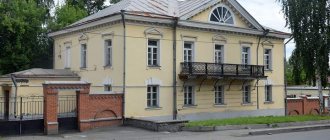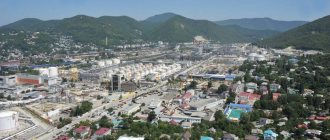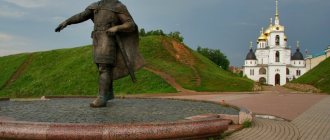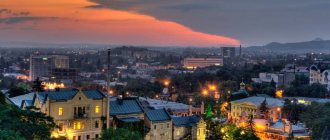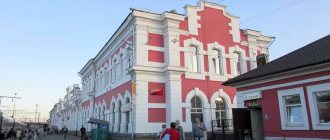The Russian city of Shakhty is located in the Rostov region. It is one of the industrial centers of the region and the main city of Eastern Donbass.
Photo: citysee.ru
Donbass usually means the Donetsk and Lugansk regions of Ukraine, parts of which formed two independent republics - the DPR and the LPR. At the same time, the eastern part of the Donetsk coal basin belongs to the Rostov region of Russia.
From the Cossack village to the city of miners
The city of Shakhty is considered the second in the Rostov region in terms of area, third in number of inhabitants and fourth in terms of economic indicators. In terms of industrial potential, only Rostov-on-Don, Taganrog and Novocherkassk are ahead of it.
The name of the city hints that it is directly related to the coal industry. In the 1990s, when coal mining enterprises began to close, the Mines fell into disrepair. True, it didn’t take the city too long to get out of its doldrums.
The history of Shakhty began with several Cossack farms. One of them, on the banks of the Grushevka River, was founded by military foreman Popov in 1805. Now this is one of the districts of the city of Shakhty called Popovka.
The fact that coal lies in these parts has been known since 1721, when it was discovered here by ore explorer G. Kapustin. Four years after his arrival here, Popov took up coal mining. He founded a well-type mine. The extracted fuel was sent to the capital of the Don Army Region, the city of Novocherkassk, and used to heat residential buildings and barracks.
In 1817, Cossack Semyon Koshkin opened his mine. Unlike Popov, he began to use horse-drawn rather than manual traction for the lift.
And then the rapid development of coal mining began. By 1839, Grushevsky Posad appeared on the site of scattered Cossack farms, and a year later the authorities decided to streamline mining. According to the new rules, local residents, having started developing a mine, had to continue mining coal until one deposit was completely depleted and only then start working on a new one.
Since the middle of the 19th century, the Russian Society of Shipping and Trade (ROPIT) has been active in the village of Grushevskaya. It began to open mines one after another. Naturally, coal miners also became concerned about transporting their products, which led to the construction of railways. And the first railway in the Don Army Region, 66 kilometers long, connected Grushevsky Posad and Aksai in 1863.
In 1867, the Cossack village of Grushevskaya received the status of a city with the name Mountain Grushevskoe settlement. There are no mountains nearby, the name does not refer to them, but to mining, that is, the extraction of minerals. And then new mining villages with colorful names began to be built here: Golodayevka, Rastastalovka, Svistovka, Nakhalovka and others.
During its history, the city, before being called Shakhty in 1920, experienced another renaming, becoming in 1881 Aleksandrovsky-Grushevsky in honor of the Russian Emperor Alexander II.
Photo: donland.ru
GKU RO "Center for storage of archival documents in the city of Shakhty, Rostov region"
The history of the city of Shakhty is the story of the transformation of a small farm into one of the largest industrial centers in the country.
It all started with the fact that during one of the Azov campaigns, soldiers found and showed Peter I a large, black stone shining in the sun, and the king saw it and said: “This mineral, if not for us, then for our descendants, will be very useful!” Then, many years later, in 1721, ore explorer Grigory Kapustin discovered coal near the Kundryuchya River and in 1722 Peter I issued a decree on searching for coal on the Don. This is how the extraction of “black gold” marked the beginning of the history of our city.
The first permanent settlement on the territory of the city of Shakhty was a farm founded in 1805, on the banks of the Grushevka River, by centurion Fedor Popov. Military foreman Vlasov settled nearby. This is how the current villages of Popovka and Vlasovka arose. Four years later, Popov built the first well-type mine, and his serfs became the first miners in the history of our city. In 1810, the Popovsky farm was sold at auction to Colonel Grekov, who continued the development of the mining business. The first mine with a horse gate was built in 1817 by Cossack Semyon Koshkin.
Then, in 1836, a royal decree appeared on the mandatory transfer of several areas where anthracite deposits were discovered to the ownership of the All-Great Don Army. Therefore, the first coal miners were representatives of the Cossack class: Koshkin, Fomin, Levitsky, Galushkin.
Subsequently, mining developed at a rapid pace and by 1845 there were 47 coal enterprises on the Don with an annual production of 1,200,000 poods. Grushevsky district ranked first in the country in coal mining. Don coal was even delivered to Moscow.
In 1856, the first government “Rules on the approval of private companies for the development of anthracite on the Don” were published. Before this, no one except the military residents themselves could engage in mining on the territory of the Region of the All-Great Don Army. After the publication of the “Rules”, many rushed for allotments for development.
In 1860 - 1864 The first railway on the Don, the Grushevsky mines - Aksayskaya station (66 versts in length), was laid. Thanks to this, Grushevsky coal gained access to the Don.
In 1864, Emperor Alexander II approved the “Regulations on mining in the land of the Don Army,” which completely eliminated the Cossack monopoly on coal mining on the Don. The “regulations” also contributed to the supply of workers to the Grushevsko-Vlasovsky coal region, since many peasants from the central Russian provinces flocked here to work, which contributed to the rapid growth of the region’s population. So, in 1880, 3,427 people lived in the Grushevsky settlement.
And already in 1883, the Grushevskoye mountain settlement was transformed into the city of Aleksandrovsk-Grushevsky, named so in memory of Emperor Alexander II and the Grushevskoye anthracite deposit. This transformation accelerated the development of the city. The city was actively developed: new streets, squares, temples, churches, and libraries appeared. In 1914, a gymnasium was opened in the city (now: PLES YURGUES). In the building of the current Shakhtinsky branch of DSTU (formerly YURGUES) there was a diocesan men's church-teachers school.
By the beginning of the 20th century, the city of Aleksandrovsk-Grushevsky had become one of the largest coal mining centers in Russia - in 1914, the city's coal industry included 57 mines. The successful development of the city also contributed to the rapid growth of its population, and by 1914 54 thousand people lived in it.
After the February Revolution of 1917, power in the city passed to the socialist revolutionaries, and after the October Revolution - to the Bolsheviks. During 1917 – 1920, the city changed hands several times from “red” to “white” and vice versa. On January 7, 1920, units of Dmitry Zhloba’s cavalry brigade entered the city, and already on January 27, 1920, a Military Revolutionary Committee was created in the city under the leadership of Khrisanf Pavlovich Chernokozov. On February 11, 920, by the Decree of the Donetsk Provincial Revolutionary Committee, the city of Aleksandrovsk-Grushevsky was renamed the city of Shakhty.
In the first years of Soviet power, the development of our city predetermined the importance of coal in the development of the entire industry of the country. Therefore, to increase the volume of coal produced, it was necessary to technically reconstruct old mines and build new ones. This, accordingly, increased the demand for electricity and made it necessary to increase generating capacity, since the old capacity was no longer sufficient. Therefore, in 1926, they began to build a new powerful power plant - the Artyom State District Power Plant. This was the first large industrial new building in the city.
Also during this period, the question of water supply to the city, whose population in 1920 was more than 38 thousand people, became acute, and at the same time, the city grew in terms of population and territorially - mining villages scattered around the city were included within the city limits. And therefore, in 1926, by decision of the district committee of the Party and the Okrug Executive Committee, construction of a new water pipeline from the Don River began, which was completed in 1928.
By the 1930s, the main problems associated with the post-revolutionary devastation had been resolved and the systematic development of the city of Shakhty as a large city and industrial center began. By 1930, there were 25 secondary schools in the city. On October 20, 1931, the Mining College was opened. In 1932–1933, the first tram line was built and put into operation. Also, during the 1930s, 11 buildings for secondary schools, a 3-story Workers' Faculty building, a two-hall cinema "Rodina", a printing house and much more were built in the city.
New mines were built and opened: in 1936, the mines named after Krasin, named after Komsomolskaya Pravda, and Novo-Azovka came into operation; in 1934, the construction of the Nezhdanaya mine was completed. On August 25, 1938, by order of the People's Commissariat of the Fuel Industry, the Rostovugol plant was created.
In general, in the pre-war period, the city of Shakhty grew and developed at a very rapid pace. This also contributed to population growth. In 1939 it was 135 thousand people.
With the beginning of the Great Patriotic War, Shakhty residents fought in a single battle formation with all the inhabitants of the country against the fascist invaders. The residents of our city made a worthy contribution to the victory over the enemy: they gave the Motherland the names of many heroes - warriors, heroes - partisans and heroes of the home front. The entire city economy was put on a war footing. Thousands of Shakhty residents of different ages and professions went to the City Military Commissariat with a request to send them to the front as volunteers. Also these days there was a rise in labor. The figures for above-plan coal production have increased. Retired miners were returning to the mines. Women housewives began to work in production to replace men who had gone to the front.
But, despite the heroic efforts of the front and rear, on July 22, 1942, German troops occupied the city of Shakhty. The dark days of the occupation began. Pursuing a policy of total terror against the civilian population, the Nazi invaders, during the occupation, tortured, shot, and starved 13,584 Shakhty residents.
However, with the arrival of the invaders, the residents of Shakhty continued to fight. The Shakhty underground was created, the organizers of which were: I.T. Klimenko, T.S. Kholodov, N.I. Gudkov, O.A. Meshkova and others. The Shakhty underground continued to fight the invaders until the liberation of the city by the 258th Infantry Division on February 12, 1943. Retreating, German troops rendered all the technical equipment of the mines unusable, and also destroyed many buildings of schools, hospitals, and cultural institutions.
However, thanks to the heroic work of the Shakhty residents, the destroyed city economy was restored as soon as possible. And already in July 1945, coal production amounted to 62% of the pre-war level.
Despite significant damage, after the war, the city began to quickly recover. Destroyed enterprises were restored and new ones were built: on December 30, 1954, the Artem No. 2 “Glubokaya” mine was put into operation, in September 1957, a fashion shoe factory came into operation, on June 27, 1959, the construction of the Shakhtinsky dairy plant was completed, etc. New schools, hospitals, vocational education institutions, cultural institutions were also restored and built: in 1951 the first music school was opened, in 1953 the Shakhtinsky Drama Theater named after N. Pogodin was opened (now the Plast Theater), in 1956 the Sports Palace was put into operation, on March 20, 1959, the Shakhty Scientific Research Institute (ShakhtNIUI) began work; in 1959, the Shakhty branch of the Novocherkassk Polytechnic Institute was opened, etc.
There was also a period in the history of the city of Shakhty when it was the administrative center of the Kamensk region, which existed from 1954 to 1957.
In the 1960s – 1980s, the city of Shakhty developed at a rapid pace as a large industrial center. During this period, many large industrial enterprises appeared in the city of the mine, such as: the state shoe factory (April 1960), the Shakhty Cotton Mill named after the 50th anniversary of the USSR (the first stage was launched in December 1970), (May 10, 1971) etc. Also in this period of time in our city there appeared: the city museum of local history (1968), a music school (June 1968), an institute of consumer services (now: Shakhty branch of DSTU), and the Aurora cinema (April 22, 1970). city), Shakhty city trolleybus (October 1, 1975), city children's hospital (January 1, 1979) and much more.
In general, by 1990, the city of Shakhty operated: 8 mines, 3 processing plants, the country's largest cotton mill, Gidroprivod, and another 65 enterprises and 37 construction organizations. All this made the city of Shakhty one of the largest industrial centers not only in our region, but also in the country as a whole.
The 1990s and early 2000s were some of the most in the history of the city, which actually experienced a period of reindustrialization, when not only the mines were closed, but also other large industrial enterprises of the city and thousands of people were left without work and livelihoods. This naturally affected the demographic situation: the city’s population decreased from 260 thousand in 1992 to 254.1 thousand in 2000. The most painful blow to the city’s economy was, in 2003, the cessation of production activities of Rostovugol OJSC.
However, even during these difficult times in the city, the city tried to live a normal life. So: in 1991, the second line was launched at the Shakhtinsky brick factory; in 1992, the first humanities gymnasium in the city and the Rostov region was opened. A.S. Pushkin, and also the children's rehabilitation center of regional significance "Dobrodeya" began operating; in 1997, the restoration of the Cathedral of the Intercession of the Blessed Virgin Mary began; in 2003, a city station for the production of oxygen for medical purposes appeared, and much more.
Since the second half of the 2000s, the socio-economic situation in the city began to gradually normalize. Some mines were restored: in 2005, the Ayutinskaya mine experienced a rebirth, and the Chikha mine and the Oktyabrskaya-Yuzhnaya processing plant were put into operation. New industrial enterprises began to be built.
Therefore, despite the difficulties experienced, the city of Shakhty continues to occupy a strategically important position in the territorial market of the Rostov region and is the most investment-attractive and promising city in the region. And you can be sure that having such a rich history, our city will eventually take its rightful place among the industrial centers not only of the south of Russia, but of the entire country.
Revolutions and miners' protests
The protest movement among miners in these parts dates back more than a century. The first major strikes took place at the ROPIT mine back in 1879. And in 1903, on May 1, the first May Day of miners took place, which was dispersed by the Cossacks. And in the same year, the Social Democratic Union of Miners of the South of Russia was created here.
During the first Russian revolution, which broke out in 1905, the strike movement intensified, the miners even created the Council of Workers' Deputies, which monitored the authorities' implementation of the strikers' demands. Already in 1906 it was dispersed, but this did not stop the strikes, which at times even developed into violent actions against the administration.
The miners of Aleksandrovsk-Grushevsky took an active part in the next revolution. In March 1917, they disarmed the gendarmes and police officers, creating their own power structure - the mine police. Soon the Soviets of Workers' Deputies were again formed, which later became the Soviets of Workers' and Soldiers' Deputies.
Of course, these events had a negative impact on coal production, the volume of which fell noticeably. Things got even worse when the Civil War broke out and the city changed hands. The events of May 1918 were especially tragic, when units of the White Guard General Krasnov entered Aleksandrovsk-Grushevsky. They immediately shot 750 people, many of whom were miners. Many were also arrested, and the Soviets and other revolutionary structures, of course, were abolished. The executions continued.
Soviet power was finally established in Aleksandrovsk-Grushevsky in January 1920, when the Red Army entered the area. And already in February the city received a new name, Shakhty.
Actually, under the new government, there was no noticeable improvement in the standard of living and working conditions of the miners, so in 1923, already under Soviet power, miners’ strikes resumed. And the reaction of the Bolsheviks to the actions of the strikers differed little from the actions of tsarist officials. For example, in 1923, a demonstration by workers of the Vlasovsko-Paramonovsky mine was dispersed, and its instigators were arrested. Looking ahead, we note that the last large-scale protest by the Miners of the Shakhty was the strikes of 1998, when the miners blocked railway traffic, putting forward their demands to the leadership of the Russian Federation.
Photo: shakhty-duma.ru
Mines during the Soviet period
From the end of the twenties, already in the USSR, the laying of new mines continued, and in order to train management personnel for coal mining enterprises in the city, the Shakhtinsky Mining College was opened in 1931. In 1933, all the city mines were united into a single structure - the Shakhtantracite trust. And in 1938, he joined the even larger Rostovugol association, which, in addition to the Shakhty trust, also included Gukovugol and Nesvetayanthracite. And the leadership of this entire association was located in Shakhty.
Coal mining here practically ceased during the Great Patriotic War, especially during the occupation period. But already in 1945, in spite of everything, the coal mining enterprises of the Shakhty started working again and produced the first coal.
In 1990, there were eight mines operating in the city. By 1995, the difficult economic situation in the country led to the closure of five of them.
Top 10 city attractions that can attract the attention of tourists
- Monument to Alexander the Second
The monument, depicting the Russian Emperor Alexander II in all its glory and majesty, is located on the main street - Pushkin Avenue. It is quite difficult to pass by this sculptural composition. That is why it is especially popular among tourists in the city.
- Monument to the Soldier-Liberator
Today this monument is one of the symbols of the city and a symbol of the victory of the Russian people. It is located on the 40th Anniversary of Victory Square. The height of the monument together with the pedestal reaches about 15 meters. Next to the soldier are the Orders of Victory, Glory and Patriotic War cast in metal. This place is popular with locals. The newlyweds and children are photographed on the square.
- Monument to Vasily Alekseev
The monument to the great Russian athlete is located in close proximity to the Sports Palace. The building of the Sports Palace itself was built and opened in the 50s of the last century. Today there are several halls in the palace (games, gymnastics, athletics, classical wrestling, boxing, weights).
10 Olympic champions emerged from the walls of this sports palace, among whom was Vasily Alekseev, a famous weightlifter, master of sports, and honored coach. He became a two-time Olympic champion in 1972 and 1976 and won eight more world weightlifting competitions.
One of the world records that he set - 645 kilograms in three exercises - has still not been defeated. The sculpture depicts the athlete at the moment of his victory.
- Monument to the Non-Returners
The memorial complex is located on the M-4 highway. On one side of the road there is a monument to a woman who peers into the horizon in anticipation of her sons. On the other side of the road there is the second part of the monument - soaring cranes that seem real.
- Monument to Taras Shevchenko
The monument to T. Shevchenko is located on the city street of the same name, next to the Technological Institute. Its opening was timed to coincide with the 150th anniversary of the Ukrainian poet.
- Holy Intercession Church
This temple was built in 1895-1902. During Soviet times, it was the only functioning church until 1933, then it was closed, the bell tower and all the domes were demolished, and the church building housed a repair shop for the tram depot. At the end of the 90s of the last century, the task was again returned to the Orthodox Church and its reconstruction began.
The painting of the temple, which is beautiful and unique in its originality, deserves special attention. Today, the temple houses many ancient icons that parishioners can admire.
- Intercession Cathedral
The temple was built on the territory of a former tram depot. The appearance of the temple is striking in its monumentality, beauty and grandeur. The temple is surrounded by a park, which is planned to be landscaped and additional buildings to be erected.
- Museum of Local Lore
Located in the city center in an old building built in 1896. Before the revolution, a parochial school was located here. Today, the museum presents more than 13,000 exhibits - ancient icons, historical documents and photographs from different eras, household items and personal belongings of city residents.
There are permanent exhibitions “Military Glory of the City”, “Philistine Life”, “Old Town”, “Nature of the Don Region”. There is an art gallery where exhibitions of painting, graphics and applied art take place, and creative musical and poetry evenings are held.
- Alexandrovsky Park
This is a central place for recreation and cultural activities in the city. The park was founded in 1895, but received its current name only in 2012. The park was named in honor of the founder of the city, Alexander II.
Now the park is undergoing a planned reconstruction, the result of which will be the appearance of a sports and park complex in it, which will include a water park, a cinema, and a zoo. In Alexander Park there is another attraction - the Alley of Heroes.
The small town of Shakhty is the birthplace of 30 soldiers who were awarded the title of Hero of the Soviet Union. Next to the alley there is another memorial complex, which includes monuments to soldiers who died during the First World War, revolution, civil war, Chechen war, as well as to those who died defending the borders of Russia and the liquidators of the Chernobyl disaster.
- Chapel of the Resurrection of the Lord
The chapel, which belonged as a family crypt to the family of the merchant Baranov, is also located in Alexander Park. It was only recently reconstructed and restored to its original form. In Soviet times, an electrical substation was located in the chapel.

